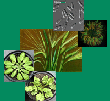| Lüttge, U; Fetene, M; Liebig, M; Rascher, U: Ecophysiology of niche occupation by two giant rosette plants, Lobelia gibberoa Hemsl and Solanecio gigas (Vatke) C. Jeffrey, in an afromontane forest Valley, Annals of Botany, 88, 267-278 (2001), doi:10.1006/anbo.2001.1450 | |
| Abstract: The niche occupation of two giant rosette plants, Lobelia gibberoa Hemsl and Solanecio gigas(Vatke) C. Jeffrey, was investigated in a small mountain valley in an afromontane forest, central Ethiopia. Plant distribution, density, life-form, morphology and microsite conditions were related to transpiration, chlorophyll a fluorescence and δ13C analysis to explain how ecophysiological traits and morphology determine the niche differentiation of plants of similar life-forms. L. gibberoa was more abundant at the humid northern flank of the valley while S. gigas was equally distributed in the northern and drier southern flanks; both species occurred in the valley bottom. Photosynthetic capacity, as determined by chlorophyll a fluorescence, was similar for both species. In dry locations, S. gigas transpired somewhat less and had lower leaf conductance for water vapour, g<$>_{{\rm H}_{2}{\rm O}}<$>, than in wet locations. Both species had the highest g<$>_{{\rm H}_{2}{\rm O}}<$>and δ13C-isotope discrimination in the wettest locations. Overall for the ecophysiological traits, site differences were larger than differences between the two species. L. gibberoa had a well developed vascular cylinder, maintained a large number of rosettes and had an average leaf area index (LAI) of 2.8, which may restrict it to the more humid locations. S. gigas, with a poorly developed vascular bundle, had many fewer rosettes, an average LAI of 1.5, and reacted more to the water status of its habitat. It was thus also capable of colonizing drier locations. The role of morphological and anatomical traits and ecophysiological features in niche occupation as revealed by assessment of vegetation is discussed. |

